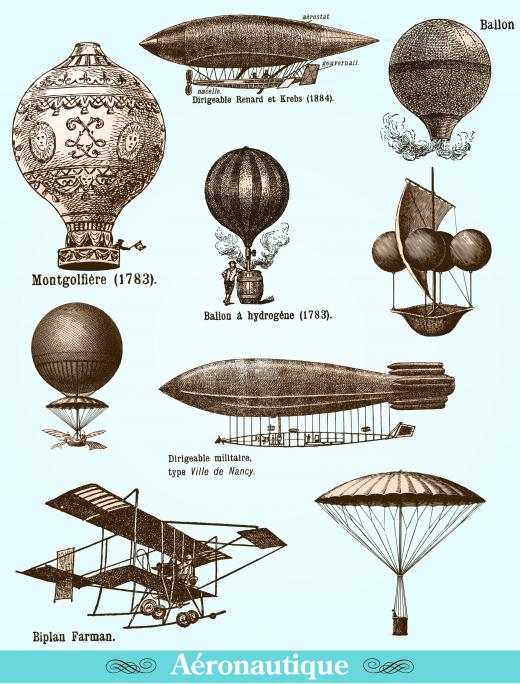What Was the Largest Airship Ever Made?
 Michael Anissimov
Michael Anissimov
The largest airship ever made was the LZ 129 Hindenburg, a German passenger airship built in 1936 for transatlantic flights. The Hindenburg went down in flames during one of the most spectacular and well-publicized transit accidents of modern times just 14 months after it was built, in May 1937, marking the end of the so-called "Age of Airships."
During its operating lifetime, the Hindenburg crossed the Atlantic 35 times, including seven round trips to Rio de Janeiro and ten round trips to New York. The last trip, from Germany to New York, ended in disaster as the world's largest airship was trying to dock in New Jersey. Though this seriously damaged the popularity of airships, they have begun to make a resurgence in modern times, though the largest airship as of 2010, the Bullet 580, is still significantly smaller than the Hindenburg.

The largest airship ever made in both length and volume, the Hindenburg had a length of 804 feet (245 m), a width of 135 feet (41 m), and a volume of about seven million cubic feet (200,000 cubic meters). In comparison, the Bullet 580 is about 235 feet (about 71 m) long and 65 feet (about 19 m) in diameter. The Hindenburg was composed of 17 gas cells compartmentalized by cotton coated with an impermeable material that served as a seal, and was filled with flammable hydrogen, which probably contributed to the fire that destroyed it. In total, the world's largest airship had a lift of 1.1 meganewtons, or 247,100 pounds, which was its approximate weight. The craft could carry 90 passengers and crew and had a maximum speed of 80 mph (135 km/h), which allowed it to cross the Atlantic in three days, a record at the time.

Before the Hindenburg, airships had been built for slightly over two centuries, since in 1784 the French Montgolfier brothers built a hot-air balloon and became the first confirmed airship passengers. It wasn't until 1853 that the first full-sized — about 145 feet (44 m) in length — airship was built, which led to the start of the "Golden Age of Airships" in 1900. This was inaugurated by the construction of the LZ 1 Zeppelin, which was the first of the Zeppelins, the most successful class of airships in history. Because heavier-than-air flight was not invented until 1903, and its usage for significant amounts of passengers remained impractical until the development of commercial jet engines in the early 1950s, airships were the world's leader in transporting passengers through the air, until their popularity waned after the Hindenburg disaster in 1937.
AS FEATURED ON:
AS FEATURED ON:













Discussion Comments
I think it's interesting what counts as an "airship." From what I understand, blimps and hot air balloons are actually considered airships. So while passenger airships like the Hindenburg aren't around anymore, I personally see airships quite frequently (advertising blimps, anyone?)
Luckily the advertising blimps are nowhere near as large as the Hindenburg!
@ceilingcat - I'm surprised you only recently learned about the Hindenburg! I think it was definitely the most famous passenger airship of all time. There are a lot of references to the Hindenburg in books and movies. I think there's even an airship in the movie Sky Captain and the World of Tomorrow (which was fairly popular) named after it!
Anyway, I have to admit I'm a bit sad that airships aren't popular anymore. I think the idea sounds really cool. And from what I've seen online in pictures of the Hindenburg, passenger airships were quite luxurious. It even had a dining room (try finding that on an airplane these days)!
I had no idea there were so many airship ventures in the early 1900s! How interesting. I actually only had a vague idea what the Hindenburg was until recently too. I happened to watch a movie that mentioned it and it sparked my curiosity!
Anyway, I'm simultaneously fascinated and horrified by the idea of airships. I can't imagine being carried over, say, an ocean by basically a large balloon. I feel like there are too many things that could go wrong! What if it sprung a leak or something?
I for one am grateful that modern airplanes were developed!
I think it is too bad that zeppelins and blimps aren't as popular now. Like someone else mentioned, though, they were kind of doomed once they found a way to make jets. I don't think anyone today would settle for getting across the Atlantic in 3 days. They wouldn't have had the same problems with blimps, since they deflate, but with a zeppelin, you also had the problem of having to have gigantic hangars to hold the airships.
On that same note, though, I did read an article not too long ago talking about how there was starting to be a spike in the number of blimps in the air. I think most people understand why they are safe now, and aren't afraid to fly in them. Most of the demand now is just from tourists to who want a bird's eye view of a city or something. It mentioned, though, that it might be very cost effective to use blimps for people who are just traveling a thousand miles or so.
I think being able to take a blimp to different places would be a nice compromise. Taking a blimp would cost less than a plane, but take a bit longer, however, it would be faster than a car.
@David09 - I think the evidence toward the Hinderburg disaster being a scandal is extremely weak compared to the other explanations. For one, like people have mentioned, the Hindenburg used hydrogen instead of helium. Even though the Germans thought it was safe, there was still always the fact that if there were to be a fire, the hydrogen would ignite. In addition to that, there weren't the same flame retardant materials in 1937 that we have now.
I don't remember the exact facts, but I am pretty sure there were poor conditions for landing at the time, and the airship had to circle around for a little while. That was mostly due to the weather, and there was very little humidity meaning the possibility of building up static on the outside material.
Even though no one knows the exact cause, by that point, all it took was a static spark, lightning or something else to set the whole disaster in motion. Maybe if the conditions weren't so good (or bad) for disaster, there might be a stronger case toward Adolf Hitler having some influence.
@JimmyT - I assume an airship can be anything that flies. When you think about it, 800 feet is absolutely massive. If you ever get a chance to watch the video, the part of the zeppelin that held the people, it is almost microscopic compared to the rest of the thing. When it crashes, too, the people look like ants next to it. Just as a matter of comparison, most planes I think are right around 200 feet or so, even though they seem larger.
I think the accident was a combination of things. Obviously, the Germans knew that hydrogen was flammable, but thought they had mastered the use of hydrogen. Also, helium was much more expensive at the time, since most countries, including Germany, didn't have the resources to make helium. Hydrogen is much lighter, as well. I think most dirigible and blimp manufacturers at the time also expected there to be a time when helium was more widely available, so built the airships in preparation for that day.
@miriam98 - Watching and listening to the broadcast of the Hindenburg disaster, you can definitely imagine the terror of the situation. What you forgot to mention, though, is that it was the birth of a phrase we still use today. At one point during the video, the person says, "Oh, the humanity," which is something people still say today even though a lot of times it is in more a light-hearted or sarcastic way.
I think it is unfortunate that it had to happen. I know I have heard the whole story before of what exactly happened, but I don't remember. Also, what exactly is meant by an "airship?" Do planes count as airships, or is that a term that is reserved for things that "float?" It is pretty interesting how the largest airship now is about one fourth of the size.
@NathanG - While I hate to say this, I think the Hindenburg disaster was inevitable given the war time conditions of the time. While some people think that a static charge caused the blimp to ignite, others have put forth the hypothesis that Hitler was behind the plot.
I am not sure the exact motivations but I certainly wouldn’t put it past him. Either way, such a slow moving blimp up in the air could easily have been a target for some attack, even if it had not been ignited from within.
Today we can use the same technology in peace time and it’s much safer. I realize that it’s rarely used for transportation except in novelty situations or if you need an advertising airship to broadcast a message over a large area like a football stadium. I think we’ve perfected the technology along the way.
@miriam98 - Yeah, there was no need for that kind of airship when regular airplanes came along. I do agree that it became synonymous with aircraft disaster.
Actually I think that every new form of technology has its own tragedies, its defining moments if you will, where the seemingly invincible technology experiences a catastrophe that temporarily casts a pall on the future of that technology.
In our day, I would have to say it was the Challenger disaster of the Space Shuttle. That was our own Hindenburg, and for a moment in time, we too wondered if the space program would continue.
As far as airship technology went the Hindenburg was definitely the Titanic of vessels. It was the largest ship of its kind and suffered the greatest and most publicized disaster, in my opinion.
Just about everyone knows about the Hindenburg airship disaster, even people who are not aviation fans, because Hindenburg became synonymous with catastrophe in that regard.
As a matter of fact if you go online you can find videos of the original reel of the Hindenburg disaster. The announcer literally breaks in tears as he describes the horrific event. Even though it ended the age of airships, however, we still have blimps.
I wonder if every time that you see a blimp up in the sky if you are reminded of the great Hindenburg disaster.
Post your comments